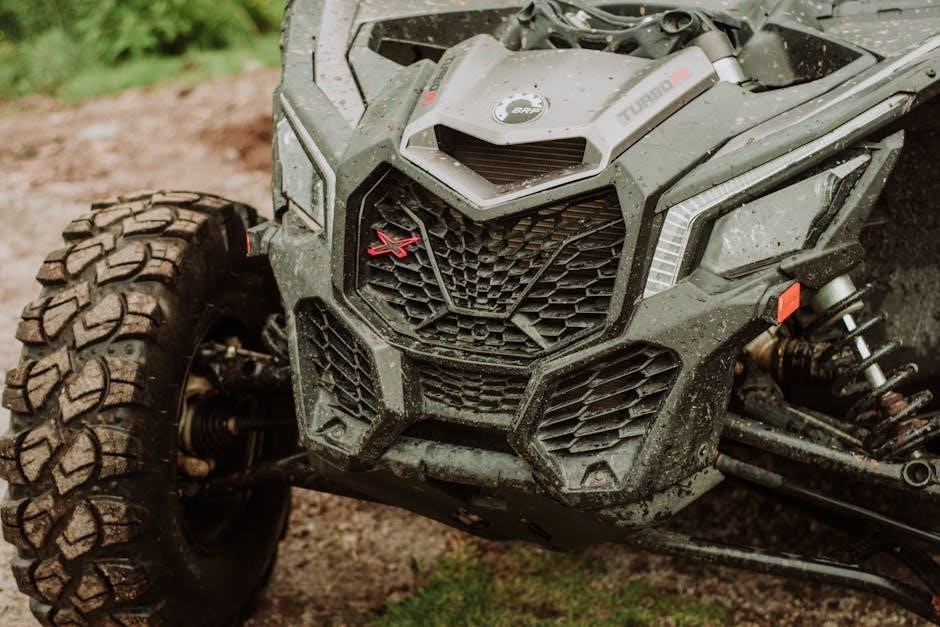Selecting the right ATV tires is crucial for performance‚ safety‚ and durability. This guide helps you understand tire specifications‚ ensuring proper fitment and optimal traction for various terrains and riding styles.
Understanding the Importance of Proper Tire Size for ATVs
Proper tire size is essential for ATV stability‚ performance‚ and safety. Incorrect sizes can lead to poor handling‚ reduced traction‚ and increased risk of accidents. Tires that are too small or too large may compromise load capacity‚ affecting the vehicle’s ability to carry weight safely. Additionally‚ mismatched tires can strain the engine and transmission‚ leading to mechanical issues. Always refer to manufacturer recommendations to ensure compatibility and optimal performance for your specific ATV model and riding conditions.

How to Read ATV Tire Sizes
ATV tire sizes are represented as a series of numbers‚ typically in the format 25×10-12. The first number (25) indicates the tire’s height‚ the second (10) is the width‚ and the third (12) is the rim diameter. This coding system helps in selecting tires that fit your ATV’s rims and meet your riding needs. Understanding these measurements is crucial for ensuring proper fitment and performance.
Breaking Down Tire Size Designations (e.g.‚ 25×10-12)
A tire size like 25×10-12 is divided into three key parts: the height‚ width‚ and rim diameter. The first number‚ 25‚ represents the tire’s diameter‚ or overall height. The second number‚ 10‚ indicates the tire’s width. The third number‚ 12‚ signifies the rim diameter‚ which must match your ATV’s wheels. These measurements are essential for selecting tires that fit properly and ensure optimal performance. Proper fitment enhances stability‚ traction‚ and safety‚ making it crucial to decode these numbers accurately.

Factors to Consider When Choosing ATV Tires
When selecting ATV tires‚ consider riding type‚ terrain‚ load capacity‚ and manufacturer recommendations. Proper fitment ensures safety‚ performance‚ and durability‚ optimizing your ATV’s overall functionality and ride quality.

Riding Type and Terrain
The type of terrain you ride on significantly impacts your tire choice; For muddy conditions‚ deep-tread mud tires with aggressive lug patterns are essential for maximum traction. Trail and all-terrain tires offer a balance of durability and versatility‚ suitable for mixed surfaces. Sand and racing tires are lightweight with specialized tread designs for high-speed performance on soft or flat terrains. Always match your tire selection to your riding style and environment to ensure optimal performance‚ safety‚ and longevity of your ATV tires.
Load Capacity and Weight Limits
Load capacity and weight limits are critical when selecting ATV tires. The load index indicates the maximum weight a tire can support‚ while the speed rating shows the maximum speed for that load. Always check your ATV’s manufacturer specifications to ensure the tires can handle the vehicle’s weight and any additional cargo. Ignoring these limits can lead to reduced stability‚ poor handling‚ or even tire failure. Properly matching your tire’s load and weight ratings ensures safe and efficient performance on all terrains and conditions.
Manufacturer Recommendations and Compatibility

Always adhere to your ATV manufacturer’s tire specifications for optimal performance and safety. Compatibility is key‚ as mismatched tires can affect handling and stability. Ensure the tires you choose align with the manufacturer’s recommended size‚ load rating‚ and speed rating. Using incompatible tires can void warranties or lead to unsafe operating conditions. Consult your ATV’s manual or contact the manufacturer for guidance. Proper compatibility ensures your vehicle performs as intended‚ regardless of terrain or load‚ and helps maintain its overall reliability and longevity.
Load Index and Speed Rating Explained
Load index indicates the tire’s maximum weight capacity‚ while speed rating shows the maximum safe speed. Both ensure safety and performance‚ making them crucial for proper fitment and safe operation.

Ensuring Safety and Performance with the Right Ratings
Ensuring your ATV tires have the correct load index and speed rating is vital for safety and performance. The load index specifies the maximum weight the tire can handle‚ while the speed rating indicates the highest speed it can maintain safely. Exceeding these limits can lead to tire failure‚ compromising both safety and handling. Always refer to your manufacturer’s guidelines to select tires that match your ATV’s specifications and your riding conditions. Proper ratings ensure optimal traction‚ durability‚ and control‚ enhancing your overall riding experience.

ATV Tire Tread Patterns and Types
ATV tires feature various tread patterns designed for specific terrains‚ such as mud‚ trails‚ or sand‚ ensuring optimal traction and performance in diverse riding conditions.

Mud Tires: Design and Features
Mud tires are specifically designed to tackle challenging‚ muddy terrains with deep treads and aggressive lug patterns. These tires feature tall‚ spaced lugs that dig into mud for superior traction and self-cleaning capabilities to expel debris. Their robust sidewalls and durable rubber compounds enhance puncture resistance and overall longevity. Designed for high torque and low-speed maneuverability‚ mud tires prioritize grip over speed‚ making them ideal for swampy or boggy conditions. Their unique tread design ensures maximum surface contact‚ even in the stickiest situations‚ providing unmatched performance in muddy environments.
Trail and All-Terrain Tires: Balancing Traction and Durability
Trail and all-terrain tires offer a versatile blend of traction‚ durability‚ and comfort for mixed riding conditions. Their tread patterns feature moderate lug depths and spacing‚ providing reliable grip on both hardpack surfaces and softer trails. Durable rubber compounds and reinforced sidewalls enhance puncture resistance‚ while their balanced design ensures smooth handling and reduced wear on paved roads. These tires are ideal for riders who demand consistent performance across diverse terrains‚ making them a practical choice for everyday use and adventure.
Sand and Racing Tires: Specialized Options
Sand and racing tires are engineered for high-speed performance and agility in specific conditions. Lightweight designs reduce unsprung weight‚ enhancing acceleration and maneuverability. Paddle tires feature unique tread patterns with large lugs and open spacing to maximize traction in sandy environments‚ while racing tires prioritize grip and stability at high speeds. These specialized tires are tailored for competitive or extreme-use scenarios‚ delivering exceptional performance but requiring careful selection to match rider needs and terrain demands precisely.
Upgrading to Aftermarket Tires
Upgrading to aftermarket tires enhances performance‚ durability‚ and traction. Consider load capacity‚ compatibility‚ and riding conditions to ensure the right fit for your ATV’s needs.
What to Know Before Upgrading Your ATV Tires
Before upgrading‚ consider your ATV’s make‚ model‚ and intended use. Check load ratings and compatibility with existing rims. Ensure the new tires meet manufacturer specifications and riding conditions‚ whether for mud‚ trails‚ or racing. Proper fitment is key to avoid performance issues and safety risks. Research brands and tread types to match your terrain needs. Always refer to sizing charts and consult professionals if unsure about modifications. Upgrading wisely ensures enhanced performance and durability.
Common Mistakes to Avoid When Selecting ATV Tires
Ignoring manufacturer specifications‚ choosing the wrong tire for terrain‚ and not considering load capacity are common errors. Avoid mixing tire sizes and ensure proper fitment for safety.

Ignoring Manufacturer Specifications
Ignoring manufacturer specifications is a critical mistake when selecting ATV tires. Every ATV model has specific tire requirements‚ and deviating from these can lead to poor performance‚ safety hazards‚ and reduced durability. Manufacturer guidelines ensure compatibility with your vehicle’s weight‚ suspension‚ and intended use. Using tires that don’t meet these standards can result in improper handling‚ instability‚ and increased wear. Always consult your ATV’s manual or manufacturer website to confirm the recommended tire size‚ load capacity‚ and speed rating for optimal safety and performance. Neglecting this step can void warranties and compromise your riding experience.
Choosing the Wrong Tire for Your Riding Conditions
Choosing the wrong tire for your riding conditions can significantly impact performance and safety. For instance‚ using mud tires on hard trails can lead to rapid wear and reduced traction. Similarly‚ trail tires in deep mud may lack the necessary aggression for optimal grip. Always match your tire tread and type to your primary riding environment‚ whether it’s mud‚ sand‚ or all-terrain. Failing to do so can result in poor performance‚ compromised durability‚ and increased risk of accidents. Ensure your tire selection aligns with your specific needs for the best results.
Frequently Asked Questions About ATV Tire Sizes
Discover answers to common questions about ATV tire sizes‚ load ratings‚ and compatibility to ensure optimal performance and safety for your vehicle.
What Is the Optimal Tire Diameter for My ATV?
The optimal tire diameter for your ATV depends on its make‚ model‚ and intended use. Typical diameters range from 20 inches for smaller machines to 30 inches for larger‚ mud-focused ATVs. Larger tires improve ground clearance and traction in deep terrain but may reduce agility. Smaller tires enhance speed and maneuverability on trails. Always consult your owner’s manual or manufacturer guidelines to ensure proper fitment and performance for your specific ATV model. Proper tire size ensures safety‚ stability‚ and optimal functionality.
Can I Mix Different Tire Sizes on My ATV?

Mixing different tire sizes on your ATV is generally not recommended‚ as it can lead to uneven traction‚ poor handling‚ and safety risks. All four tires should match in size and type to ensure proper stability and control‚ especially during sharp turns or high-speed riding. However‚ some riders experiment with slightly different sizes front-to-back for specific performance needs. Always consult your ATV’s manufacturer guidelines before making any modifications to ensure compatibility and safety.